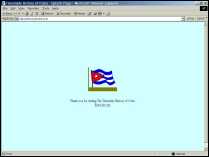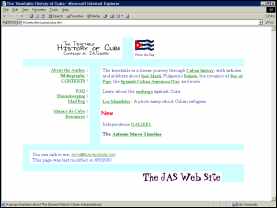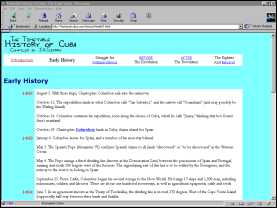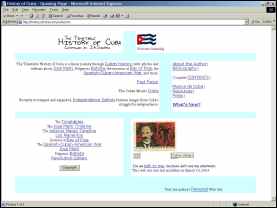
Two Decades Online:
History of historyofcuba.com
By Jerry A. Sierra

In the face of time, two decades may be less than a drop of water on the Pacific Ocean. In the face of history, two decades is but a breath of fresh air in a long and fruitful life. In the time span of Cuban history, two decades is but a fraction of the time spent fighting for independence from Empires that would claim her. On the Internet today, two decades is almost forever.
This website began in 1995 as a small sector on THE JAS WEB SITE, a personal and experimental HTML2 site that provided me with a way to learn and explore HTML and this great new thing called cyberspace. The site included various short stories, an article on photomontage that I originally wrote years earlier for Petersen’s Photographic Magazine, a picture gallery and a brief section on Cuban history.

In 1996 the Cuban history sector grew out of control and demanded its own environment, so THE TIMETABLE HISTORY OF CUBA emerged as its own entity, separate from the personal site but still within its borders. I consider this the official birth of Version One. In May 1998, historyofcuba.com was established on its own domain.
Back then the “timetables” consisted of a list of dates with no pictures and a few links to short articles about Martí and Maceo. Within a few years, the site reached a total word count of nearly 2,000 words. Over the next decade the site grew to its current word count of over 207,097 words!

From the beginning, the site generated lots of Email – mostly questions about issues in Cuban history, corrections and praise from teachers and students, who encouraged further development and complained about inaccuracies and omissions in the history texts that school districts force on them. The Internet was a polite place full of curious and friendly people… for a while. Then came the many politically motivated messages from left- and right-wing extremists, arguing their political point of view, often with more passion than facts. Cuba seems to elicit a great deal of passion from those who encounter her mysterious charms, and the wrong word can quickly label you “pro” or “con” on the Castro question, regardless of your actual views. Gray areas are discouraged.
I was also working as a freelancer and maintained a full-time job. There was often little or no time for Cuban history, but I always seemed to have a couple of library books around with the word “Cuba” on the cover.
It was now time to get serious. I began to take stock of the site’s strengths and weaknesses and worked to improve the overall reach of the material. It was obvious that I would have to learn about topics in Cuban history that had previously been of little interest to me previously, such as, basically, the twentieth century.
In between absorbing all the web-tech I could, I began to seek books, journal articles and conversations that would open my eyes to my history. Soon it became, again, a big curious passion in my life.
For a while, in the early days, historyofcuba.com was the only source of online information on Cuban history, as even the major encyclopedias had little or no information on the island, and other sites had patches of information, but nothing complete or thorough. Early versions of Encarta listed Marti’s birthdate as 1835 (it was 1853). Something had to be done.

Without realizing it, I began to spend considerably more time answering Email questions and looking for ways to turn the responses into new content. Sometimes the questions would launch me into a “whole lotta” research. The articles on the Sierra Maestra, Raul Castro, the Cuban flag, and the Ten-Year War, to name a few, began as responses to Email questions and evolved into short pieces for the site.
A New Century
A new week. A new month. A new year. A new decade. A new century. A new millennium. All on one day. It was a Monday.
Sometime before the end of the Clinton Administration, I decided to devote all my freelance time to the site exclusively.
Instead of writing articles about software programs that would be outdated within a year, I could do something useful (though less financially profitable) with my time.
The site began to blossom.
Around 2004-5, the site began another quiet, behind the scenes organizational re-design that included a new logo, faster-loading pages, and accommodation for new and upcoming content. The main look and feel of the site remained, and overall performance was improved with a wider implementation of Cascading Style Sheets (CSS).
v.9
With v.9 (2005) the site achieved what I had long hoped for: a more visual look, with many more images from Cuban history than anywhere else on the English-speaking corner of the Internet. V.9 also achieved what I consider a personal milestone: no tables (except on some image galleries—but I was going to get around to those… really) and complete reliance on style sheets. This meant better accessibility and faster loading pages. At this time the site also made a complete shift towards higher resolution images and colors.
Although this version catered to the many users of the site and their requests, it suffered from “too many links” in “too many places” as well as a vague sense of… confusion.
v.10
V.10 was not just the tenth version of the site on what could be its tenth birthday (an exact birthdate has never been determined) it was a new commitment, a renewal of the vows made when the world (wide web) was young and idealistic.
Aside from correcting the obvious problems from v.9, an important concept for v.10 was “clear user options.” After ten years, the obvious structure for the site became ingrained in memory.

User options are spelled out in detail in the page HOW TO USE THIS SITE. It’s now possible to start exploring Cuban history from a number of entry points, all of which can be found on the home page to suit different goals and personality types.
Due to pressing projects and a return to the halls of academia (2008-2011) there were large periods of time in which the site remained untouched and unchanged. During these times, however, I continued with my personal exploration of Cuban history.
v.2020
Since then, the site has evolved in small and gradual steps without bothering to identify versions.
To start the 3rd decade of our 21st century, the site is undergoing a major refactoring process that will allow users to better use the site on their mobiles while still maintaining the basic look and functionality they expect on the desktop. This process is proceeding slowly and carefully but may not be completed as rapidly as I would like.
Que Viva Cuba!